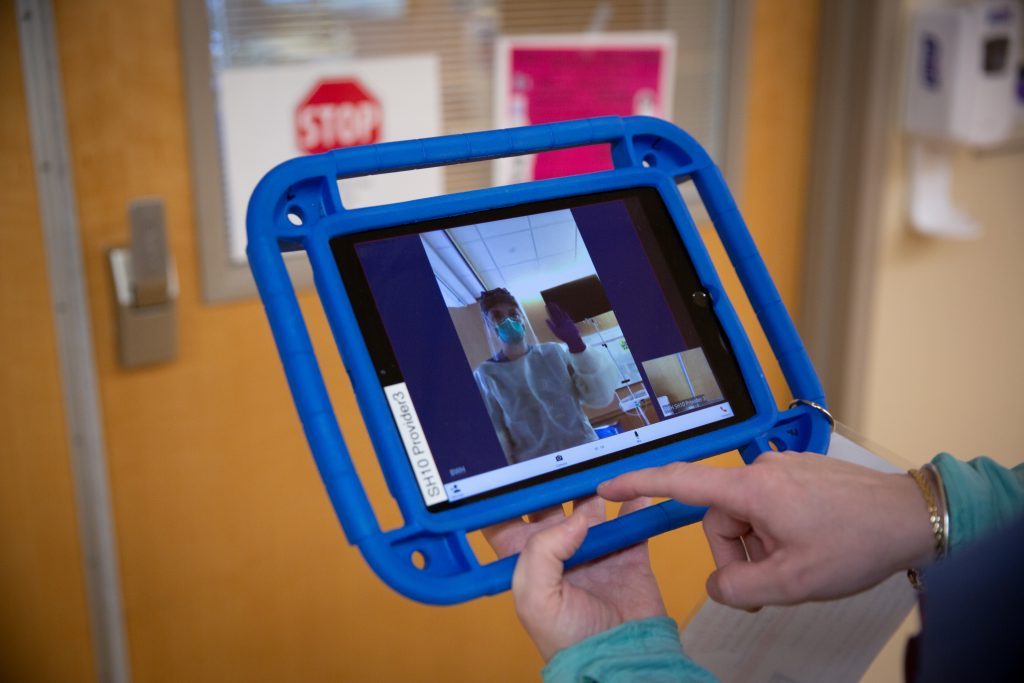Digital Technology Becomes Essential Part of Patient Care

Peter Chai demonstrates “Spot,” a robot used in the Emergency Department to remotely triage COVID-19 patients. Photo credit: Susan Symonds/Mainframe Photographics
Physical distancing remains one of the most important and effective measures for preventing the spread of COVID-19, but it initially presented clinicians with a dilemma: How do you safely deliver care when face-to-face interactions suddenly pose so many challenges?
One compelling solution: digital technology.
The meteoric rise of virtual care and rapid adoption of new technologies across Brigham Health helped keep staff, patients and families healthy, safe and connected throughout the pandemic. From the booming expansion of existing programs to the swift implementation of new ones, multidisciplinary teams used mobile devices, video conferencing and even robots to continue delivering expert care with compassion.
“Before COVID, there was almost no virtual care happening in our acute care settings, and less than 1 percent of ambulatory visits were done virtually,” said Adam Licurse, MD, MHS, executive director of Virtual Care for Brigham Health. “That changed nearly overnight.”
‘A Game-Changer’
When the spread of COVID-19 prompted the Brigham to shutter most ambulatory clinics in mid-March, the Virtual Care team and Information Services (IS) staff came together to support hundreds of providers who were caring for patients remotely for the first time.
In February, prior to COVID-19’s widespread presence in the Northeast, Brigham outpatient providers collectively conducted 200 virtual visits. In May, they completed 80,000.
“Very quickly, we had to train nearly all outpatient providers on how to do visits over the phone and by video,” Licurse said. “It was a huge mobilization of resources and communication, including guidance around regulatory issues and reimbursement, in addition to procuring and distributing a lot of new equipment like webcams.”
Primary care physician Lilian Mahrokhian, MD, completed approximately 500 virtual visits between March and May, mostly from her home via video. In May alone, her appointment volume exceeded that of a typical October, historically the busiest month for primary care.
“It’s been a game-changer. Patients have loved the opportunity to see and talk with us, and it has been invaluable to check in with them while keeping all of us safe,” said Mahrokhian, who practices at the Fish Center for Women’s Heath. “I keep thinking, what if this pandemic had hit at a time when this technology wasn’t in place? We would not be able to deliver this type of care as effectively.”
Mahrokhian, an enthusiastic proponent of telehealth prior to the pandemic, said that while not every condition can be treated remotely, many aspects of primary care are well-suited to the model.
“There’s a lot of counseling we can do in primary care that translates well to virtual care,” she said. “An in-person exam is not as relevant for evaluating a patient’s response to an antidepressant or helping them manage weight loss.”
Mahrokhian said she was exceptionally grateful to Virtual Care and IS teams who worked behind the scenes to continually monitor the system, respond to providers’ needs and quickly implement improvements.
“As a provider, I felt really supported,” she said. “It seemed like they were working tirelessly to get this up and running for us, and there was always someone available to help if I ran into any issues.”
Keeping Everyone Safe
Inside the hospital, where care teams needed to maintain in-person contact with patients, the use of technology flourished in creative ways as staff sought to minimize exposure to COVID-19, conserve personal protective equipment (PPE) and help patients and families remain connected while most visitors were prohibited.
A video intercom system enabled hospitalized patients with COVID-19 and their providers to interact via secure video conferencing. Through a bedside iPad in the patient’s room, clinicians could initiate a video chat using a computer or mobile device — relieving providers from needing to enter patient rooms for every routine question or conversation.
Thanks to the innovative work of a multidisciplinary team — led by Cheng Zhang of Virtual Care, Greg Kane of Analytics, Planning, Strategy and Improvement, and Laura Carroll and Steve Penney of Brigham Health IS — the group deployed nearly 400 iPads in only a few weeks.
To help nurses wearing full PPE in patient rooms communicate more easily with colleagues on the other side of the door, Brigham Health IS staff also expanded the hospital’s use of Vocera, a system of lightweight, wearable badges that staff can clip to scrubs or a gown for hands-free, real-time voice communication.
“A silver lining of the COVID-19 pandemic has been the rapid adoption of new technology. We have achieved years of digital transformation in just a few months,” said Adam Landman, MD, vice president and chief information and digital innovation officer at Brigham Health. I’m especially proud of the BH Information Systems, Virtual Care and Digital Innovation Hub (iHub) team members, who worked tirelessly to rapidly deploy these new tools to front-line clinicians.
Additionally, the pandemic transformed daily rounds, as several inpatient units used iPads to conduct virtual rounds to limit the number of providers who needed to enter a patient’s room.
Hospitalist Karen Jiang, MD, medical director for BWFH’s 7 North, normally conducts rounds on her own, but during the pandemic she found that conducting virtual rounds with a trainee was helpful in juggling the many tasks at hand.
“Even though we didn’t have as many patients, I spent much more time and energy planning each interaction,” Jiang said. “I had to think a lot about hand-washing, wiping things down, gowning and de-gowning each time, so to have another person helping with other needs, such as taking notes, allowed me to stay more focused on everything I needed to do in the room.”
In the Emergency Department (ED), a research team piloted the use of Boston Dynamics’ four-legged robot, known as “Spot,” which was equipped with a video conferencing-enabled tablet. By sending Spot to interact with patients in a triage tent outside the ED, providers could evaluate patients while conserving PPE.
Other uses of digital technology were more internally facing, such as the COVID Pass app, a mobile app and web-based portal staff used to attest to their wellness each day before reporting to work. The multidisciplinary project, which was deployed across the entire Mass General Brigham system, was led by Landman and Mark Zhang, DO, MMSc, medical director of the Brigham Digital Innovation Hub, with app development completed by the MGB IS Application Development team.
Staying Connected
Technology also became an essential means of maintaining human connection, such as when staff on Connors Center 7 donned party hats and used the video intercom system to sing “Happy Birthday” to their patient.
To support patients who didn’t have access to personal devices, a device loaner program enabled any hospitalized patient to borrow mobile devices and laptops to stay in touch with loved ones through apps like Zoom and FaceTime.
Additionally, a virtual family visit program also provided an opportunity for patients and their loved ones to connect through staff-facilitated video sessions at the bedside. Ngoc Vu, a medical assistant in the Neurosciences Center who was redeployed to support the program, coordinated and conducted eight to 10 video sessions each day throughout the pandemic.
While holding an iPad so that a patient and their loved one could see each other and speak, Vu often used her free hand to offer a comforting touch, such as holding the patient’s hand, during the session.
“Sometimes the conversations were very sad, but other times they were happy — the patient was doing well and getting extubated, and the family members were excited to see them,” she said. “It gave me a new appreciation for how precious life is and how important these connections are.”



Leave a Reply